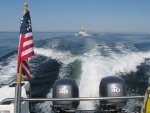Foggy, "what Roger said" though at displacement speed, even if accidentally some how it was put in reverse, I doubt the force of the water would turn over the motor enough to create water flow into the engine. Now a friend of mine has twin Yamaha 250's on a 26 foot Hewescraft & it is unsteerable with one motor raised. It really moves along on the one 250, so if the off down motor was in reverse, no doubt it wouldn't turn out good, but as he's a retired mechanic, he's even less inclined then perhaps the rest of us to put the motor that is off in reverse. That said, it's always good to see just what the manufacturer recommends, so thanks for the post.
Paul, I find it interesting that you have difficulty steering with one motor up with the Baystar steering unit, as that's the unit I have too & for me the ease of moving the wheel is about the same no matter the position of the motors, though I've heard from others like the one, I referenced to Foggy, that have similar or worse than you.
Sunbeam, yes lots of +'s & -'s in twins vs single usage, so it comes down to personal preference of which, several items tip the scale in favor of twins for us, but I prefer the twins mostly because, that's what I'm use to now after 14 seasons of running them & like you, like the "look".
In my opinion, the downside of your deluxe kicker idea is no matter how deluxe, it isn't going to steer the boat as well as the larger twins with both down & one running. They are good for trolling & for emergency back to safe waters, but not for long distance & time slow cruising in areas such as SE Alaska on a boat like a CD 22. Now I imagine a small kicker type motor on a matching sailboat just the ticket. Though the better the set up, the more favorably it will compare on a CD22.
Potter Water, my statistics & evidence is lacking too on a debate, between whether running at displacement speed with twins on one motor running or both is the best choice, but the preponderance of the discussions, I've read & heard on this & my own opinion is running one motor at a time with twins at displacement speed is the better of the choices. I wish at least on fuel usage, that someone could provide good records running both ways over a substantial time period. I know when we're in rougher sea conditions any advantage thought to be gained by running on one motor for overall cost savings is not worth it, compared to the added control gained by running both motors. One motor running is done only in what we judge to be applicable sea conditions, which in the last two seasons has been near 87% of our total running time. I agree that engine load has much to do with engine longevity & fuel consumption, but we differ in the preferred amount of load. My choice is to run one motor at a time at the higher load, so as to work it just hard enough, that switching between the motors often or needing to run them several times during the day at a high rpm is not necessary. In doing this, I tend to run one motor for the majority of the day if not the whole day, using time over the long run to balance out the hours. This also prevents the many cold starts one has to do if making frequent switches. I will continue to do this my way, until I receive good data to change. Until then the advancing trouble free engine hours will have to be my conformation of at least if not the best method, at least not harmful either. So far, at 2115 hours & their never having ran smoother, l'll maintain this course.
All the service maintenance & most other maintenance has been done by me on our CD22 & I plan on running these motors until a major repair is needed. I'm hoping that doesn't occur until at least the 3000 hour mark or higher. So far the 1999 Honda's have been amazedly trouble free with most of the work done on them being preventative maintenance. By doing my own work, I've already saved in service maintenance alone, near the cost of one replacement motor.
Greg, if this is what you are getting from this thread, I suggest you reread my reports of our travels & see if you really think any standard kicker set up would have safely maneuvered us or anyone else 70% of the time to all the places we've been at a boat controlling speed of 6 to 7 mph & yes the battery charging is a necessity too. Of course a large single would have at displacement speed, but no way with a standard kicker.
Jay

